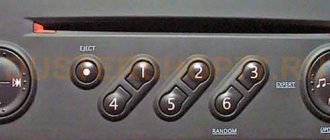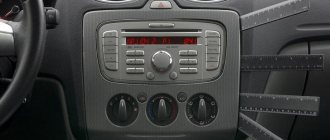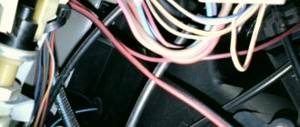Greetings! I think that there are hardly many users who would not want high speed and performance from their laptop. In this situation, it seems natural to have an undying interest in the topic of increasing performance and overclocking.
The processor plays a key role in the operation of a computer; performance and speed of performing certain tasks also depend on it. By overclocking the processor, you can achieve an increase in speed and performance of tasks on a laptop, in some cases quite significant.
This review will talk about methods for increasing the performance of laptops from a variety of manufacturers: ASUS, HP, DELL, ACER, Lenovo, MSI, etc.
Well, let's get started.
Please note that overclocking involves operating some components under stress. This can affect performance (overheating, etc.) and ultimately lead to breakdown of your existing equipment. You do the actions described in this material at your own peril and risk.
Utilities that we will need to implement our plan:
SetFSB
(overclocking program). The utility works in demo mode, but there is also a free version, which is a little older. Official website of the utility.
PRIME95
– a utility whose task is to test the stability of the processor. The program is free, you can download it from the official website.
It should be noted that the above utilities can be replaced by analogues, of which there are a number. But this review will be built using exactly these utilities.
Checking motherboard support
First you need to find out the name of the motherboard. If you do not have such data, then use special software, for example, the CPU-Z program.
After you have determined the brand of the board, go to the official website of the SetFSB program. The design there, to put it mildly, is not the best, but all the necessary information is there. If the board is on the list of supported ones, then you can happily continue further.
Download Features
The latest versions of this program, unfortunately, are paid for the Russian-speaking population. You will need to deposit approximately $6 to receive your activation code.
There is an alternative - download the old version of the program, we recommend version 2.2.129.95. This can be done, for example, here.
Installing the program and preparing for overclocking
The program works without installation. After launch, this window will appear in front of you.
To start overclocking, you first need to know your clock generator (PLL). Unfortunately, it is not so easy to recognize him. Computer owners can disassemble the system unit and find the necessary information manually. The data looks something like this:
Methods for software identification of a PLL chip
If you have a laptop or don’t want to disassemble your PC, then there are two more ways to find out your PLL.
1. Come here and look for your laptop in the table. 2. The SetFSB program will help you determine the PLL chip brand itself.
Let's look at the second method. Switch to the “ Diagnosis ” tab, select “ PLL diagnosis Clock Generator , and then click on the “ Get FSB ” button.
We go down below, into the “ PLL Control Registers ” field and see a table there. We look for column 07 (this is Vendor ID) and look at the value of the first line:
• if the value is xE, then PLL from Realtek, for example, RTM520-39D; • if the value is x1, then PLL from IDT, for example, ICS952703BF; • if the value is x6, then PLL from SILEGO, for example, SLG505YC56DT; • if the value is x8, then PLL from Silicon Labs, for example, CY28341OC-3.
Sometimes exceptions are possible, for example, for chips from Silicon Labs - in this case, the Vendor ID will be located not in the seventh byte (07), but in the sixth (06).
Checking protection against software overclocking
You can find out if there is hardware protection against software overclocking:
• look in the “ PLL Control Registers ” field at column 09 and click on the value of the first line; • look in the “ Bin ” field and find the sixth bit in this number. Please note that the bit count must start from one! Therefore, if the first bit is zero, then the sixth bit will be the seventh digit; • if the sixth bit is 1, then for overclocking via SetFSB you need a PLL hardware mod (TME-mod); • if the sixth bit is 0, then a hardware mod is not required.
Overclocking Xeon e5 on Chinese socket 2011 motherboards
You can slightly overclock Xeon e5 processors of the 1600 and even 2600 series (both v1 and v2), running on Chinese motherboards such as huanan x79, its clones and other similar Chinese motherboards.
Currently known boards that support overclocking via setFSB:
- Early revisions
- and earlier
FSB from 90 to 110 MHz are available without any modifications. As a rule, FSB overclocking is limited to 103~107MHz (which gives a 3-7% increase).
Overclocking is saved after rebooting or shutting down the computer (if there is a unit on duty), and is reset after the system unit is de-energized after a few tens of seconds. That is, if during the process of overclocking, you install a piece of data that is not suitable for the processor or memory - just unplug the computer from the socket and wait a little, after that everything will start at the default frequencies.
The SetFSB clocker does not support Chinese motherboards, so you won’t be able to use the sliders.
- Diagnosis tab, select clock generator - PLL diagnosis, click GetFsb and 9 bytes of configuration registers are read from the clocker. We are interested in byte No. 6, click on it with the mouse (red arrow 1), and its value in binary form will be loaded into field 2.
- The lowest 4 bits are responsible for FSB. We take their values in the top table and edit them in field 2. For example, if we want 106.25, we change 00011000 to 00011101.
- After this, press update (3), close all tasks and save the documents and click apply (4). After this, fsb will be set to the specified value.
There is one thing - the computer may freeze at the moment of changing fsb, then turn it off with the power button (holding it) and turn it on. The percent will work at the given fsb (if the memory and itself can do it) until the power is turned off.
What to do after overclocking?
We need to find out how stable the computer operates at the new frequency. This can be done, for example, in games or specialized programs for tests (Prime95 or others). Also monitor the temperature to avoid possible overheating when the processor is under load. In parallel with the tests, run a temperature monitor program (CPU-Z, HWMonitor or others). Tests are best completed in approximately 10-15 minutes. If everything works stably, then you can stay at the new frequency or continue to increase it, performing all the above actions in a new circle.
How to force the PC to start at a new frequency?
You should already know that the program works with the new frequency only until a reboot. Therefore, in order for the computer to always start at the new system bus frequency, it is necessary to put the program in startup. This is a must if you want to use an overclocked computer on a regular basis. However, in this case we are not talking about simply adding a program to the Startup folder. There is a way to do this - creating a bat script.
Opens Notepad , where we will create the script. We write a line there, something like this:
C:DesktopSetFSB 2.2.129.95setfsb.exe –w15 –s668 –cg[ICS9LPR310BGLF]
ATTENTION! DO NOT COPY THIS LINE! It should turn out different for you!
So, let's break it down:
C:DesktopSetFSB 2.2.129.95setfsb.exe is the path to the utility itself. Your location and version of the program may vary! -w15 — delay before starting the program (measured in seconds). -s668 - overclocking setting. Your number will vary! To find it out, look at the green field in the Control tab of the program. There will be two numbers separated by a slash. Take the first number. -cg[ICS9LPR310BGLF] is the model of your PLL. Your data may be different! You must enter the model of your PLL in square brackets as it is specified in SetFSB.
By the way, along with SetFSB itself you will find a text file setfsb.txt, where you can find other parameters and apply them if necessary.
Once the line has been created, save the file as .bat.
The last step is to add the baht to startup by moving the shortcut to the “ Startup ” folder or by editing the registry (you will find this method on the Internet).
In this article, we examined in detail how to properly overclock a processor using the SetFSB program. This is a painstaking process that will ultimately give a noticeable increase in processor performance. We hope everything will work out for you, and if you have any questions, ask them in the comments, we will definitely answer them.
Thank the author and share the article on social networks.
A motherboard is a multifunctional platform that ensures the functionality of each component of a personal computer: RAM, video card, hard drives, and central processor. Therefore, it is important to figure out whether the components will be compatible with the motherboard before purchasing additional equipment. The only way to deal with the task at hand is to find out the model of the motherboard already installed in the system unit. And, as practice suggests, there are more options for performing this operation than it seems at first glance...
Overclocking instructions
So, before you begin the overclocking process, you need to install the SetFSB program. This program is considered the most secure and allows you to easily change the system bus frequency.
Next, run the program you installed by double-clicking on it with the left mouse button. Study the program thoroughly. As you can see, the program has a very simple and intuitive interface, and even novice users should not have any problems using it.
Go to the second tab, which is called “Control” and you will see the current frequency of the system bus of your processor and a little lower a slider that allows you to change its value.
On the third tab, called “Customize,” you can change additional system parameters.
Try experimenting with the program settings, only be careful when changing the processor bus frequency. The frequency needs to be increased a little bit at a time, for example increased by 50 MHz, immediately check the processor temperature and if everything is fine, then add 50 MHz and so on.
In order to configure the parameters of your processor directly from the operating system, install the CPU Tweaker program. This program allows you to change computer settings without increasing heat generation and energy consumption.
The main thing when overclocking and tuning is not to overdo it, so that later you don’t have to buy a new processor or computer.
SetFSB is a specialized utility for quickly and easily overclocking your CPU. Typically used for overclocking laptops, but can also be useful for regular PCs, including those running on Xeon processors.
Using this utility, you can easily change the system bus frequency without rebooting the system. The program has a very simple and friendly interface, and overclocking is carried out using the slider movement. Despite its ease of use and ease of overclocking, this utility is not recommended for use by beginners.
Ignorance of the architecture and possible limits of your processor and motherboard can render both of them unusable.
How to find out your motherboard model using Windows
The Windows operating system copes with the task of checking the hardware in no time. Moreover, in both Windows XP and Windows 8, the procedure is the same - you will have to refer to the “System Information” section, which is accessible using the msinfo32 command (the procedure will be described below). Every detail related to a personal computer is displayed there - the amount of RAM, the current video card, operating system, hard drive capacity. But there is no alternative way to tell you about the installed motherboard in Windows (except from the command line) - neither Device Manager nor computer properties will tell you about the “main hardware”, and will only shed light on additional components.
Step-by-step instructions on how to overclock the processor on a laptop using Windows
You now know all the pros and cons. It's time to talk about how to overclock the processor on a laptop. To do this, you will need to go into the BIOS.
However, before overclocking the processor, do the following:
- Clean your laptop from various “garbage”. That is, delete unnecessary files from the device’s hard drive.
- Optimize windows. For example, remove unnecessary applications from startup or disable services that you do not use.
- Eliminate system errors.
- Update your drivers.
- Check your laptop for viruses. And the best way is to use several programs.
The fact is that many people start overclocking the processor on a laptop. But in fact, the device slows down and freezes for trivial reasons - the operating system is not configured properly, malicious software interferes with the computer’s operation, etc. So first we eliminate all errors, remove unnecessary files and viruses, speed up the CPU speed by installing fresh drivers, etc. Once you are done with this, you can move on to the process of overclocking the processor.
The easiest and safest way is to change the power supply mode. This overclocking option works on any laptop from any manufacturer - Asus, Lenovo, Acer, HP, Samsung, Dell, etc. For example, let's look at the whole process on a device running Windows 10:
- Through “Start” we go to the “System” section.
- On the left, select “Power and sleep mode”.
- Next, click on “Advanced power settings”. The corresponding button will be on the right.
- Now in the window that appears, expand the “Show additional schemes” menu.
- Set the marker to “High Performance” mode.
How to find out the “clock generator” of the motherboard?
Only the SetFSB tool can deal with the task, and therefore you will have to act as follows: * Download the archive with the tool from the official website.
- Immediately after the test run, enter the identification number located at the top of the interface into the empty text field (in the screenshot, for example, you can see the combination 1726030115).
- After a kind of license check has been completed, a new information and reference window will appear, which lists a colossal amount of various information. Including the Clock Generator indicator. If the specified window is empty, you will have to either test again, or close SetFSB, and then re-enter the identification number in the empty text window. As practice suggests, the necessary information will definitely appear the third or fourth time.
Surprisingly, analogs of SetFSB have not yet appeared on the Internet. Therefore, to check Clock Generator you will have to follow the instructions described above!
How to find out the manufacturer of the motherboard on a laptop
The equipment available in a laptop or netbook, although it differs from the “standard” in size, interacts with the motherboard and additional components here in exactly the same way (of course, not counting visual inspection - on a laptop or netbook such things should be dealt with in the last place - it’s too high when disassembling the case, there is a risk of damaging the cables leading to the monitor or keyboard, or violating the current warranty). For example, using AIDA64 or Speccy, or alternatively:
- CPU-Z – Initially, the tool told only about the processor, but later additional information appeared - for example, the name and name of the motherboard, the cooler used, current BIOS information, version of graphical interfaces, RAM speed. If desired, the developers offer to output especially important data to a TXT file. So, they say, you won’t be able to lose important parameters even with a strong desire.
- HWiNFO32 is another help desk service available on Windows XP, 7, Vista, 8 and 10, both in full format and in a Portable version that can be easily downloaded to an external drive for use anywhere you need Find out the model of the motherboard on your computer. On the plus side, information is collected at lightning speed, and it’s free. Russian language included. For beginners who have not yet understood computer basics, hints are available using a special question mark, which is located opposite each information point. It’s worth spending a little more time and many more details will be revealed.
How else can you find out what motherboard is on your computer? Use tips for Windows 10. About using the Command Prompt and the Run command.
Author: Yuri Belousov · 01/29/2019
In the process of overclocking an old laptop's processor using software (for example, SetFSB), the user may need to specify his PLL chip installed on the motherboard. And here the question arises: “ How can I find out the model of the PLL (Clock Generator) chip on a laptop ?”
Using PLL
PLL (Phase-Locked Loop) is a special oscillator with a frequency adjustment circuit, it is a voltage-controlled oscillator (VCO - voltage-controlled oscillator). The generator implements a comparison of the phases of the input frequency signal and the output frequency signal. The measured phase difference of these frequencies, through negative feedback, precisely controls the frequency of the generator, fixing it at a given value. PLLs are widely used in telecommunications, computers and other electronic devices. I note that the MAX II series chip, which is on our first Mars Rover board, did not have built-in PLLs. The Altera MAX II series is too simple. The Altera Cyclone III chip installed on the new Mars Rover2 board has built-in PLLs. This is a very important component because the PLL usually creates all the frequencies needed for the design in a design. This is why you need to get to know PLL better.
Let's look at the operating principle of PLL. A certain input frequency of the reference oscillator Fin is supplied to the PLL input. Next, on the N-counter, the reference frequency is divided and another frequency Fref is obtained, which is fed to the PFD phase detector (phase-frequency detector). The phase detector compares the phases of Fref frequencies and that coming from the M-counter divider. The phase difference is filtered and controls the VCO oscillator. The output of the controlled generator is the new frequency Fvco. The phase detector supplies a control action to the VCO generator until the condition Fref = Fvco / M is met. Under this condition, the frequencies supplied to the phase detector are equal. Thus, for example, if M=2, then the frequency of the VCO oscillator should be 2 times higher than the Fref frequency. The last stage is the frequency Fvco is divided at the output counter K-counter. By selecting the coefficients N, M, K, you can synthesize a fairly large range of frequencies. More complex PLL components allow coefficients to be reloaded while the system is running. This was a fairly simplified presentation. You can read more about the operation of PLLs in the Altera documentation, for example about the Cyclone III chip: Clock Networks and PLLs in the Cyclone III Device Family. In this Alter documentation, for example, the PLL block diagram is depicted like this:
It seems complicated, but essentially the same as I pictured above.
Now let's come down to earth and see how to use these PLLs in projects for Cyclone III and in particular for the Mars Rover2 . Everything is quite simple here. In the ALtera Quartus II environment, launch the wizard through the Tools => MegaWizard Plug-In Manager menu.
Select Create a new custom megafunction variation and click Next.
In the new window, on the left, select Installed Plug-Ins => I/O => ALTPLL. On the right, select which HDL language to generate the component in, for example, Verilog, and below set the name of the new file. Click the Next button.
Here the wizard itself is launched, which is actually associated with the ALTPLL component. We set the parameters we need. There are many parameters. In most cases, many of them do not need to be installed. For example, use Select the PLL type automatically and also In normal mode. Among the important parameters is the type of microcircuit according to the project (Cyclone III), the value of the input frequency is the frequency of the generator installed on the board. On our board, Mars Rover 2 is 100 MHz. And also indicate the speed grade of the microcircuit - for us it is 8. Click the Next button.
On the next wizard screen, mark which PLL signals you need. Do you need a PLL areset reset in your project? or permission to run PLL pfdena? Do you need a signal indicating that the desired frequency is locked? Make a decision about these signals and click Next. I will allow myself to skip 3 wizard screens so as not to bore the reader too much. I’ll skip the Spread Spectrum settings - this is about the possibility of frequency deviation at the PLL output, I’ll also skip ClockSwitchover - the ability to connect a second input frequency, and for now I’ll skip Dynamic Reconfiguration. This is quite a special topic. Maybe some other time.
And here is the main screen of the wizard. Here we must set the multiplication and division coefficients for the original frequency to get the frequency we need. You can set the coefficients yourself manually or set the desired frequency and Quartus II Wizard itself will calculate the coefficients, which you then need to copy. For example, for the first project to work on the Mars Rover2 board for the 1440×900 60Hz video mode, a frequency of 106.5 MHz is required according to the VESA standard. I indicate 106.5 in the Requested Settings window and they ask me to multiply the frequency by 213 and divide by 200! So that's great! If at the top of the window it says in blue Able to implement requested PLL, then everything is working out. Note that the Cyclone III PLL can have 5 outputs: C0, C1, C2, C3, C4. Each of the outputs can be independently configured to a given frequency. True, the frequencies will turn out to be more or less connected. For example, you can get a grid of 33 MHz, 66 MHz, 133 MHz, 166 MHz - they have a common coefficient of 33. It is difficult or impossible to get a grid of unrelated frequencies. For each PLL output there will be a corresponding wizard page with settings.
Having gone through the wizard to the end, we get some generated files. A *.BSF file is a component that can be inserted into a schematic if you are doing a schematic design. A file like mypll.v is a Verilog module, copies of which can be inserted into your own Verilog modules. This is probably all the initial information for using PLL in projects for the Altera Cyclone III chip.
How to find out the PLL chip model on a laptop motherboard
Ways to find out the model of the PLL chip (Clock Generator) on a laptop motherboard:
- Disassemble the laptop and look at the PLL chip markings on the board;
- Find data about the chip on the Internet by searching, indicating the motherboard model;
- Using the selection method in the overclocking program.
There is no point in using programs like Everest, Aida64 and CPU-Z; they will not provide information that will help you find out the Clock Generator of the motherboard on a laptop.
It is worth noting that you can only determine the PLL chip model by disassembling the laptop if you are using a very old motherboard. On modern motherboards, the PLL chip is already embedded into the chipset chip. There is no use looking for him.
I hope the article “How to find out the model of a PLL chip (Clock Generator, clocker) on a laptop” was useful to you.
Didn't find the answer? Then use the search form:











